Analysis of Leadership, Job Design, and Crisis Management in Education
VerifiedAdded on 2020/05/01
|16
|3471
|408
Report
AI Summary
This report delves into several crucial aspects of educational management and leadership. It begins by examining the significance of job design, emphasizing its impact on employee motivation and productivity, and explores tools like job enlargement and enrichment. The report then defines educational leadership, differentiating between various leadership types, including instructional, distributed, transformational, and strategic leadership, and highlights the indispensable relationship between learning and leadership. Furthermore, it discusses the role of the decision-making process in educational management, providing examples, and outlines strategies for managing resources within a training center. The report also emphasizes the importance of 'Quality Assurance' and the transformative essence of training, while also addressing how to resolve crisis situations within an educational institution, providing core points and examples. The report provides a comprehensive overview of key concepts and practical strategies for effective leadership and management in an educational setting.
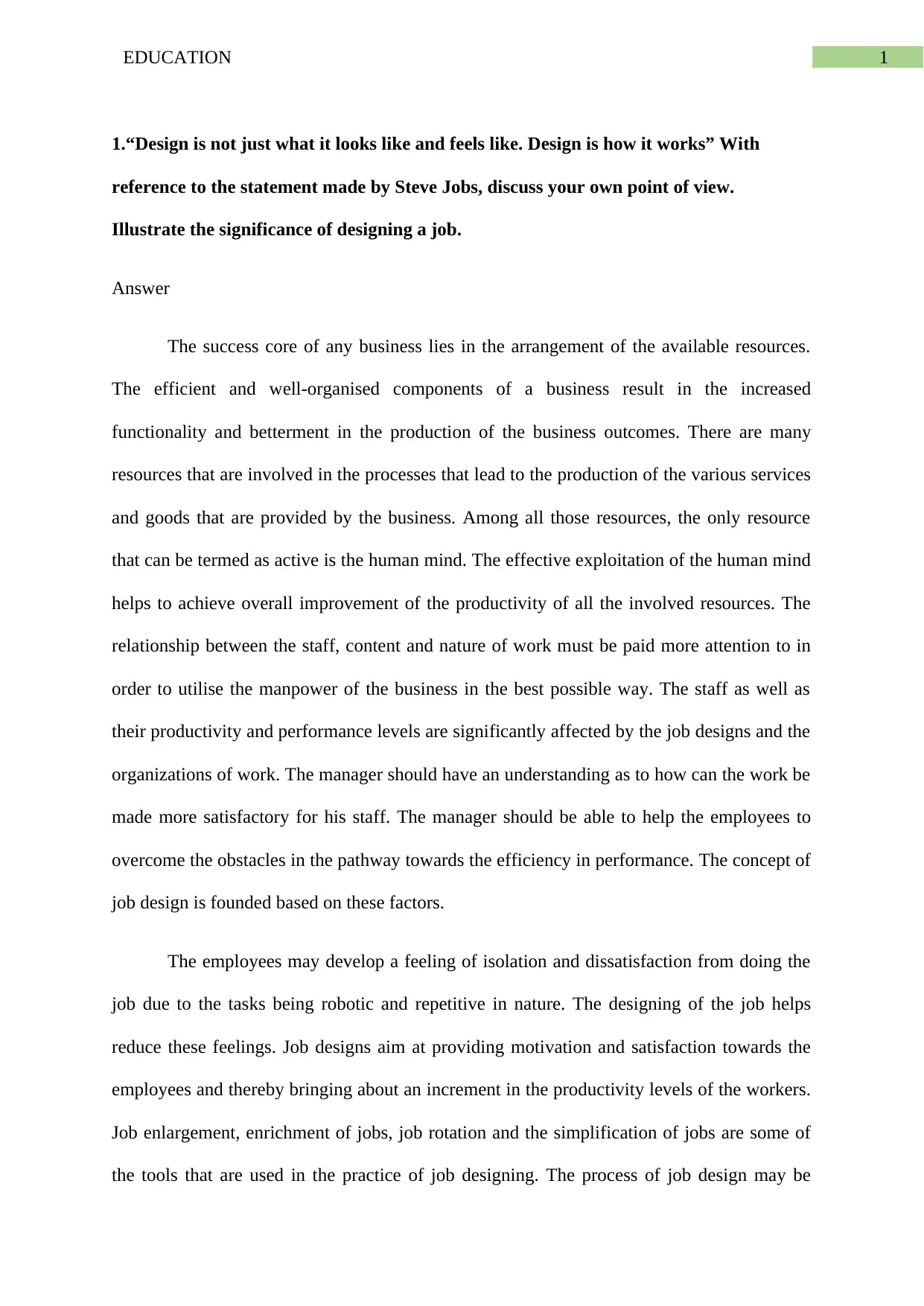
1EDUCATION
1.“Design is not just what it looks like and feels like. Design is how it works” With
reference to the statement made by Steve Jobs, discuss your own point of view.
Illustrate the significance of designing a job.
Answer
The success core of any business lies in the arrangement of the available resources.
The efficient and well-organised components of a business result in the increased
functionality and betterment in the production of the business outcomes. There are many
resources that are involved in the processes that lead to the production of the various services
and goods that are provided by the business. Among all those resources, the only resource
that can be termed as active is the human mind. The effective exploitation of the human mind
helps to achieve overall improvement of the productivity of all the involved resources. The
relationship between the staff, content and nature of work must be paid more attention to in
order to utilise the manpower of the business in the best possible way. The staff as well as
their productivity and performance levels are significantly affected by the job designs and the
organizations of work. The manager should have an understanding as to how can the work be
made more satisfactory for his staff. The manager should be able to help the employees to
overcome the obstacles in the pathway towards the efficiency in performance. The concept of
job design is founded based on these factors.
The employees may develop a feeling of isolation and dissatisfaction from doing the
job due to the tasks being robotic and repetitive in nature. The designing of the job helps
reduce these feelings. Job designs aim at providing motivation and satisfaction towards the
employees and thereby bringing about an increment in the productivity levels of the workers.
Job enlargement, enrichment of jobs, job rotation and the simplification of jobs are some of
the tools that are used in the practice of job designing. The process of job design may be
1.“Design is not just what it looks like and feels like. Design is how it works” With
reference to the statement made by Steve Jobs, discuss your own point of view.
Illustrate the significance of designing a job.
Answer
The success core of any business lies in the arrangement of the available resources.
The efficient and well-organised components of a business result in the increased
functionality and betterment in the production of the business outcomes. There are many
resources that are involved in the processes that lead to the production of the various services
and goods that are provided by the business. Among all those resources, the only resource
that can be termed as active is the human mind. The effective exploitation of the human mind
helps to achieve overall improvement of the productivity of all the involved resources. The
relationship between the staff, content and nature of work must be paid more attention to in
order to utilise the manpower of the business in the best possible way. The staff as well as
their productivity and performance levels are significantly affected by the job designs and the
organizations of work. The manager should have an understanding as to how can the work be
made more satisfactory for his staff. The manager should be able to help the employees to
overcome the obstacles in the pathway towards the efficiency in performance. The concept of
job design is founded based on these factors.
The employees may develop a feeling of isolation and dissatisfaction from doing the
job due to the tasks being robotic and repetitive in nature. The designing of the job helps
reduce these feelings. Job designs aim at providing motivation and satisfaction towards the
employees and thereby bringing about an increment in the productivity levels of the workers.
Job enlargement, enrichment of jobs, job rotation and the simplification of jobs are some of
the tools that are used in the practice of job designing. The process of job design may be
Paraphrase This Document
Need a fresh take? Get an instant paraphrase of this document with our AI Paraphraser
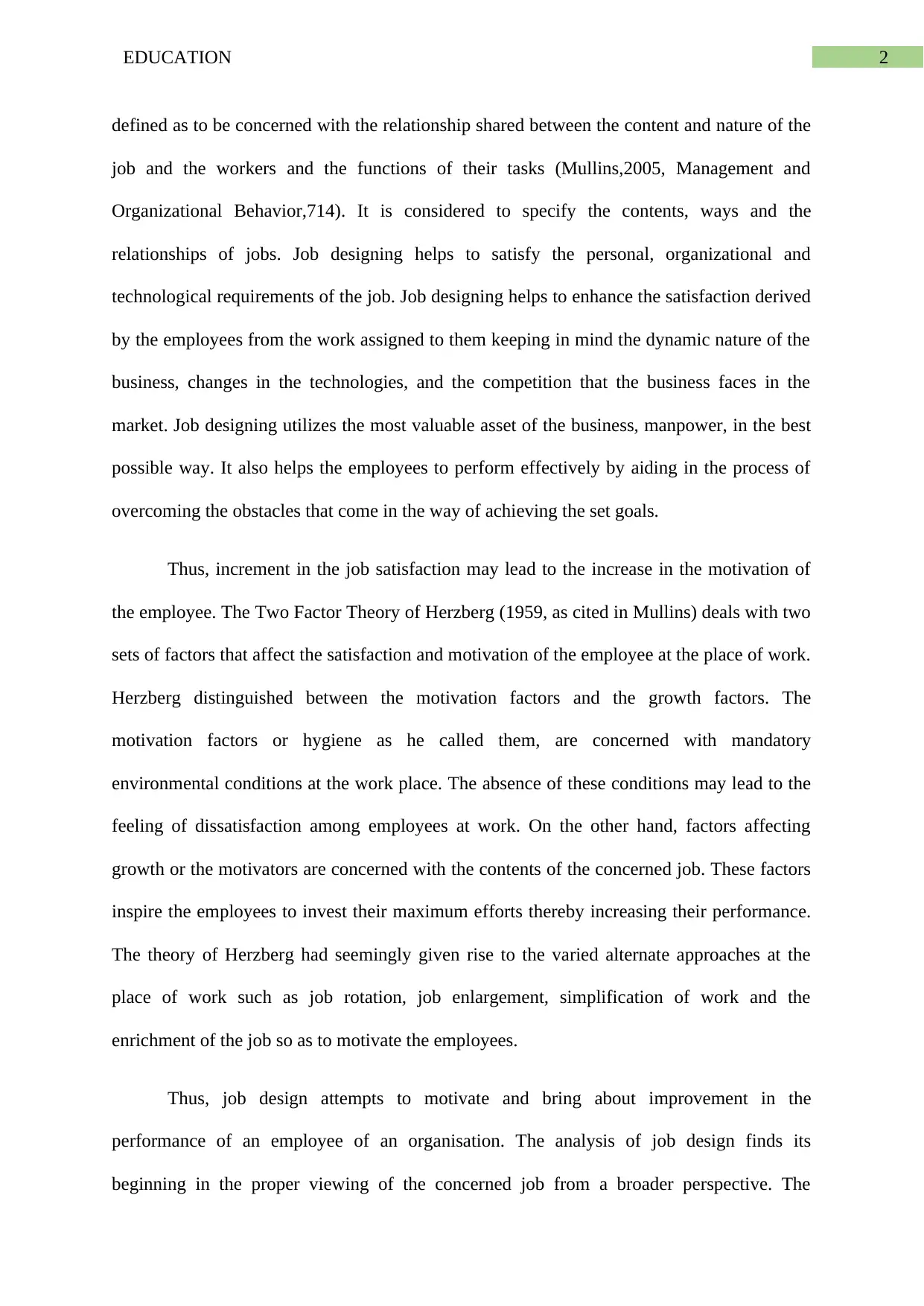
2EDUCATION
defined as to be concerned with the relationship shared between the content and nature of the
job and the workers and the functions of their tasks (Mullins,2005, Management and
Organizational Behavior,714). It is considered to specify the contents, ways and the
relationships of jobs. Job designing helps to satisfy the personal, organizational and
technological requirements of the job. Job designing helps to enhance the satisfaction derived
by the employees from the work assigned to them keeping in mind the dynamic nature of the
business, changes in the technologies, and the competition that the business faces in the
market. Job designing utilizes the most valuable asset of the business, manpower, in the best
possible way. It also helps the employees to perform effectively by aiding in the process of
overcoming the obstacles that come in the way of achieving the set goals.
Thus, increment in the job satisfaction may lead to the increase in the motivation of
the employee. The Two Factor Theory of Herzberg (1959, as cited in Mullins) deals with two
sets of factors that affect the satisfaction and motivation of the employee at the place of work.
Herzberg distinguished between the motivation factors and the growth factors. The
motivation factors or hygiene as he called them, are concerned with mandatory
environmental conditions at the work place. The absence of these conditions may lead to the
feeling of dissatisfaction among employees at work. On the other hand, factors affecting
growth or the motivators are concerned with the contents of the concerned job. These factors
inspire the employees to invest their maximum efforts thereby increasing their performance.
The theory of Herzberg had seemingly given rise to the varied alternate approaches at the
place of work such as job rotation, job enlargement, simplification of work and the
enrichment of the job so as to motivate the employees.
Thus, job design attempts to motivate and bring about improvement in the
performance of an employee of an organisation. The analysis of job design finds its
beginning in the proper viewing of the concerned job from a broader perspective. The
defined as to be concerned with the relationship shared between the content and nature of the
job and the workers and the functions of their tasks (Mullins,2005, Management and
Organizational Behavior,714). It is considered to specify the contents, ways and the
relationships of jobs. Job designing helps to satisfy the personal, organizational and
technological requirements of the job. Job designing helps to enhance the satisfaction derived
by the employees from the work assigned to them keeping in mind the dynamic nature of the
business, changes in the technologies, and the competition that the business faces in the
market. Job designing utilizes the most valuable asset of the business, manpower, in the best
possible way. It also helps the employees to perform effectively by aiding in the process of
overcoming the obstacles that come in the way of achieving the set goals.
Thus, increment in the job satisfaction may lead to the increase in the motivation of
the employee. The Two Factor Theory of Herzberg (1959, as cited in Mullins) deals with two
sets of factors that affect the satisfaction and motivation of the employee at the place of work.
Herzberg distinguished between the motivation factors and the growth factors. The
motivation factors or hygiene as he called them, are concerned with mandatory
environmental conditions at the work place. The absence of these conditions may lead to the
feeling of dissatisfaction among employees at work. On the other hand, factors affecting
growth or the motivators are concerned with the contents of the concerned job. These factors
inspire the employees to invest their maximum efforts thereby increasing their performance.
The theory of Herzberg had seemingly given rise to the varied alternate approaches at the
place of work such as job rotation, job enlargement, simplification of work and the
enrichment of the job so as to motivate the employees.
Thus, job design attempts to motivate and bring about improvement in the
performance of an employee of an organisation. The analysis of job design finds its
beginning in the proper viewing of the concerned job from a broader perspective. The
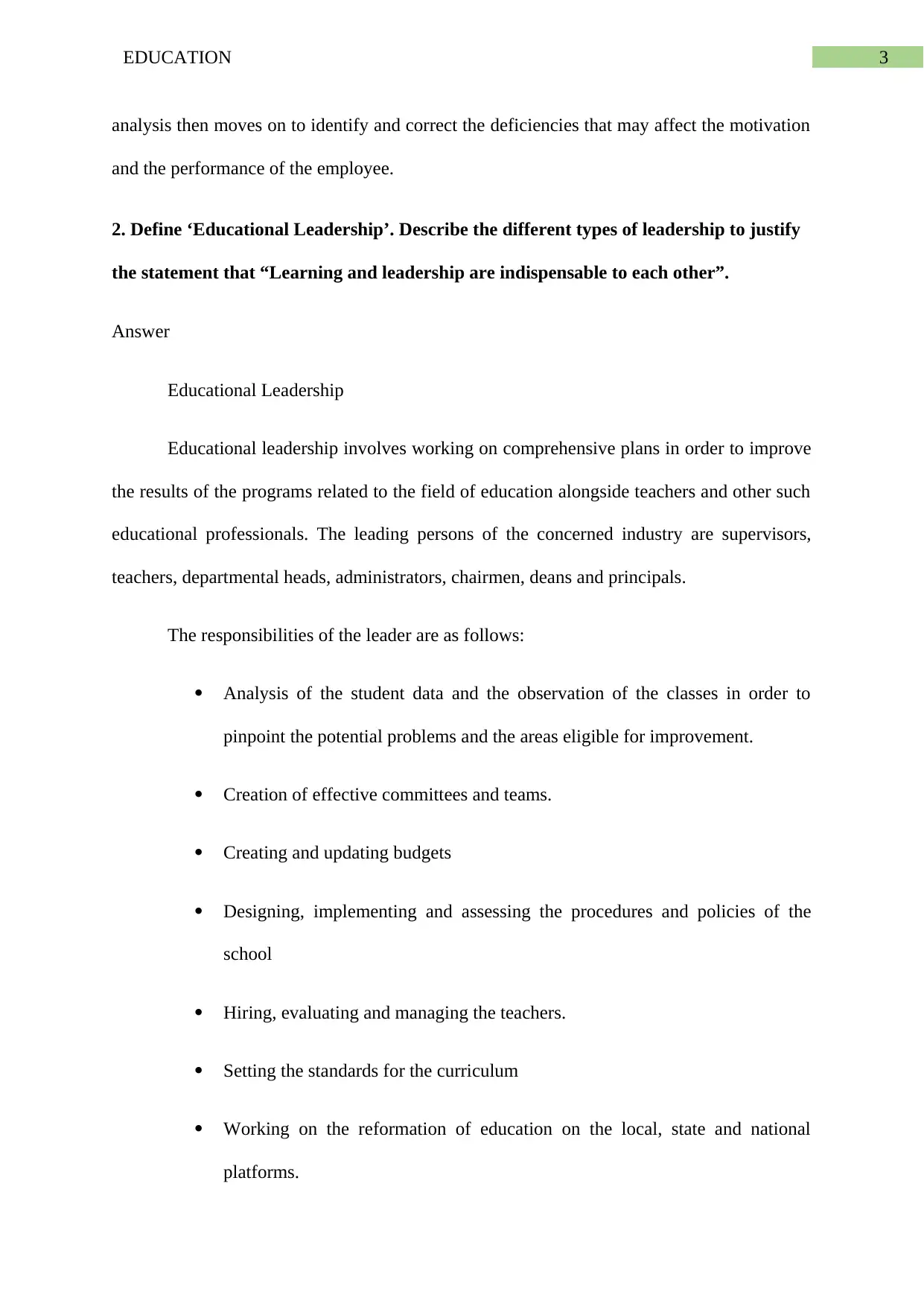
3EDUCATION
analysis then moves on to identify and correct the deficiencies that may affect the motivation
and the performance of the employee.
2. Define ‘Educational Leadership’. Describe the different types of leadership to justify
the statement that “Learning and leadership are indispensable to each other”.
Answer
Educational Leadership
Educational leadership involves working on comprehensive plans in order to improve
the results of the programs related to the field of education alongside teachers and other such
educational professionals. The leading persons of the concerned industry are supervisors,
teachers, departmental heads, administrators, chairmen, deans and principals.
The responsibilities of the leader are as follows:
Analysis of the student data and the observation of the classes in order to
pinpoint the potential problems and the areas eligible for improvement.
Creation of effective committees and teams.
Creating and updating budgets
Designing, implementing and assessing the procedures and policies of the
school
Hiring, evaluating and managing the teachers.
Setting the standards for the curriculum
Working on the reformation of education on the local, state and national
platforms.
analysis then moves on to identify and correct the deficiencies that may affect the motivation
and the performance of the employee.
2. Define ‘Educational Leadership’. Describe the different types of leadership to justify
the statement that “Learning and leadership are indispensable to each other”.
Answer
Educational Leadership
Educational leadership involves working on comprehensive plans in order to improve
the results of the programs related to the field of education alongside teachers and other such
educational professionals. The leading persons of the concerned industry are supervisors,
teachers, departmental heads, administrators, chairmen, deans and principals.
The responsibilities of the leader are as follows:
Analysis of the student data and the observation of the classes in order to
pinpoint the potential problems and the areas eligible for improvement.
Creation of effective committees and teams.
Creating and updating budgets
Designing, implementing and assessing the procedures and policies of the
school
Hiring, evaluating and managing the teachers.
Setting the standards for the curriculum
Working on the reformation of education on the local, state and national
platforms.
⊘ This is a preview!⊘
Do you want full access?
Subscribe today to unlock all pages.

Trusted by 1+ million students worldwide
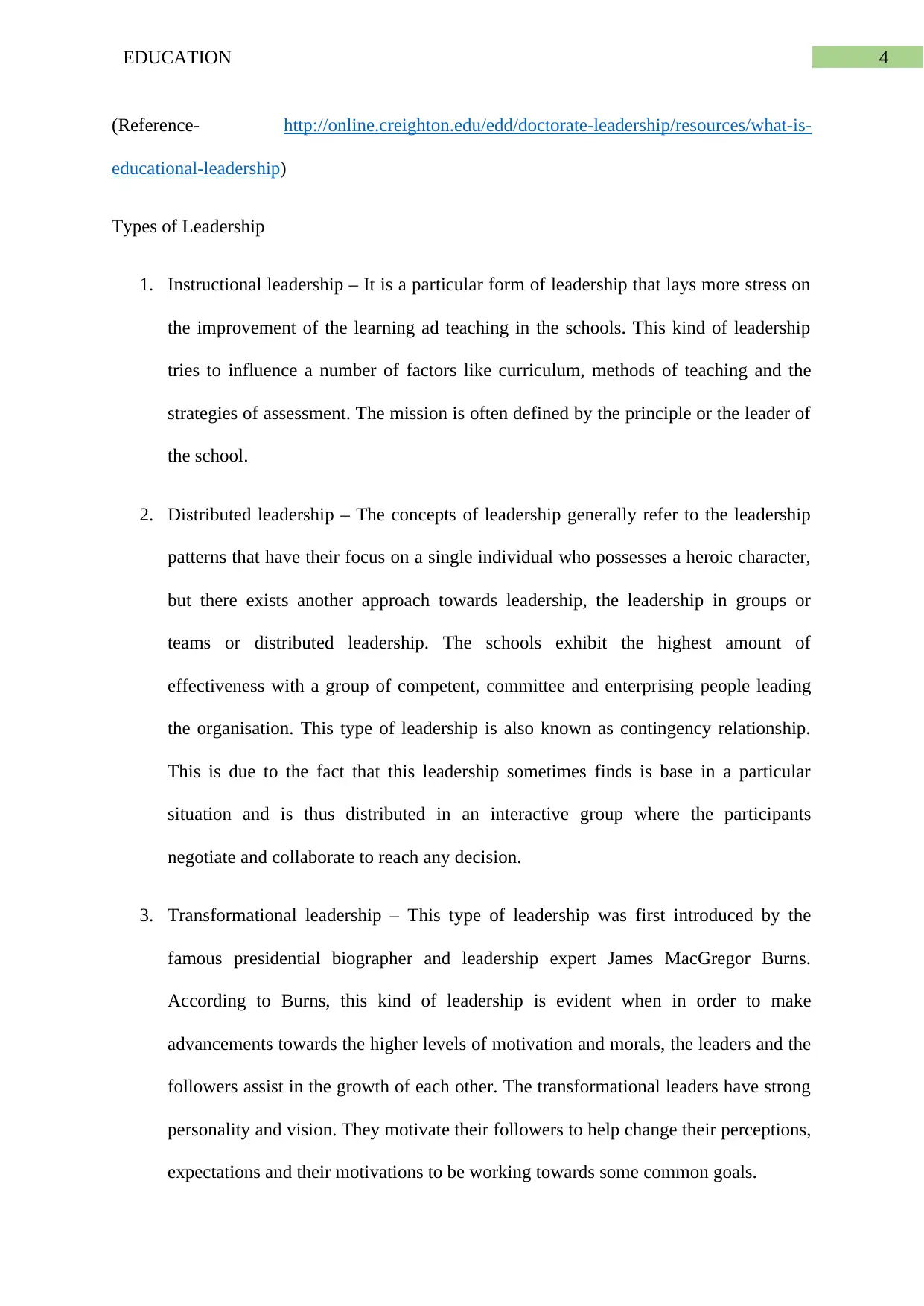
4EDUCATION
(Reference- http://online.creighton.edu/edd/doctorate-leadership/resources/what-is-
educational-leadership)
Types of Leadership
1. Instructional leadership – It is a particular form of leadership that lays more stress on
the improvement of the learning ad teaching in the schools. This kind of leadership
tries to influence a number of factors like curriculum, methods of teaching and the
strategies of assessment. The mission is often defined by the principle or the leader of
the school.
2. Distributed leadership – The concepts of leadership generally refer to the leadership
patterns that have their focus on a single individual who possesses a heroic character,
but there exists another approach towards leadership, the leadership in groups or
teams or distributed leadership. The schools exhibit the highest amount of
effectiveness with a group of competent, committee and enterprising people leading
the organisation. This type of leadership is also known as contingency relationship.
This is due to the fact that this leadership sometimes finds is base in a particular
situation and is thus distributed in an interactive group where the participants
negotiate and collaborate to reach any decision.
3. Transformational leadership – This type of leadership was first introduced by the
famous presidential biographer and leadership expert James MacGregor Burns.
According to Burns, this kind of leadership is evident when in order to make
advancements towards the higher levels of motivation and morals, the leaders and the
followers assist in the growth of each other. The transformational leaders have strong
personality and vision. They motivate their followers to help change their perceptions,
expectations and their motivations to be working towards some common goals.
(Reference- http://online.creighton.edu/edd/doctorate-leadership/resources/what-is-
educational-leadership)
Types of Leadership
1. Instructional leadership – It is a particular form of leadership that lays more stress on
the improvement of the learning ad teaching in the schools. This kind of leadership
tries to influence a number of factors like curriculum, methods of teaching and the
strategies of assessment. The mission is often defined by the principle or the leader of
the school.
2. Distributed leadership – The concepts of leadership generally refer to the leadership
patterns that have their focus on a single individual who possesses a heroic character,
but there exists another approach towards leadership, the leadership in groups or
teams or distributed leadership. The schools exhibit the highest amount of
effectiveness with a group of competent, committee and enterprising people leading
the organisation. This type of leadership is also known as contingency relationship.
This is due to the fact that this leadership sometimes finds is base in a particular
situation and is thus distributed in an interactive group where the participants
negotiate and collaborate to reach any decision.
3. Transformational leadership – This type of leadership was first introduced by the
famous presidential biographer and leadership expert James MacGregor Burns.
According to Burns, this kind of leadership is evident when in order to make
advancements towards the higher levels of motivation and morals, the leaders and the
followers assist in the growth of each other. The transformational leaders have strong
personality and vision. They motivate their followers to help change their perceptions,
expectations and their motivations to be working towards some common goals.
Paraphrase This Document
Need a fresh take? Get an instant paraphrase of this document with our AI Paraphraser
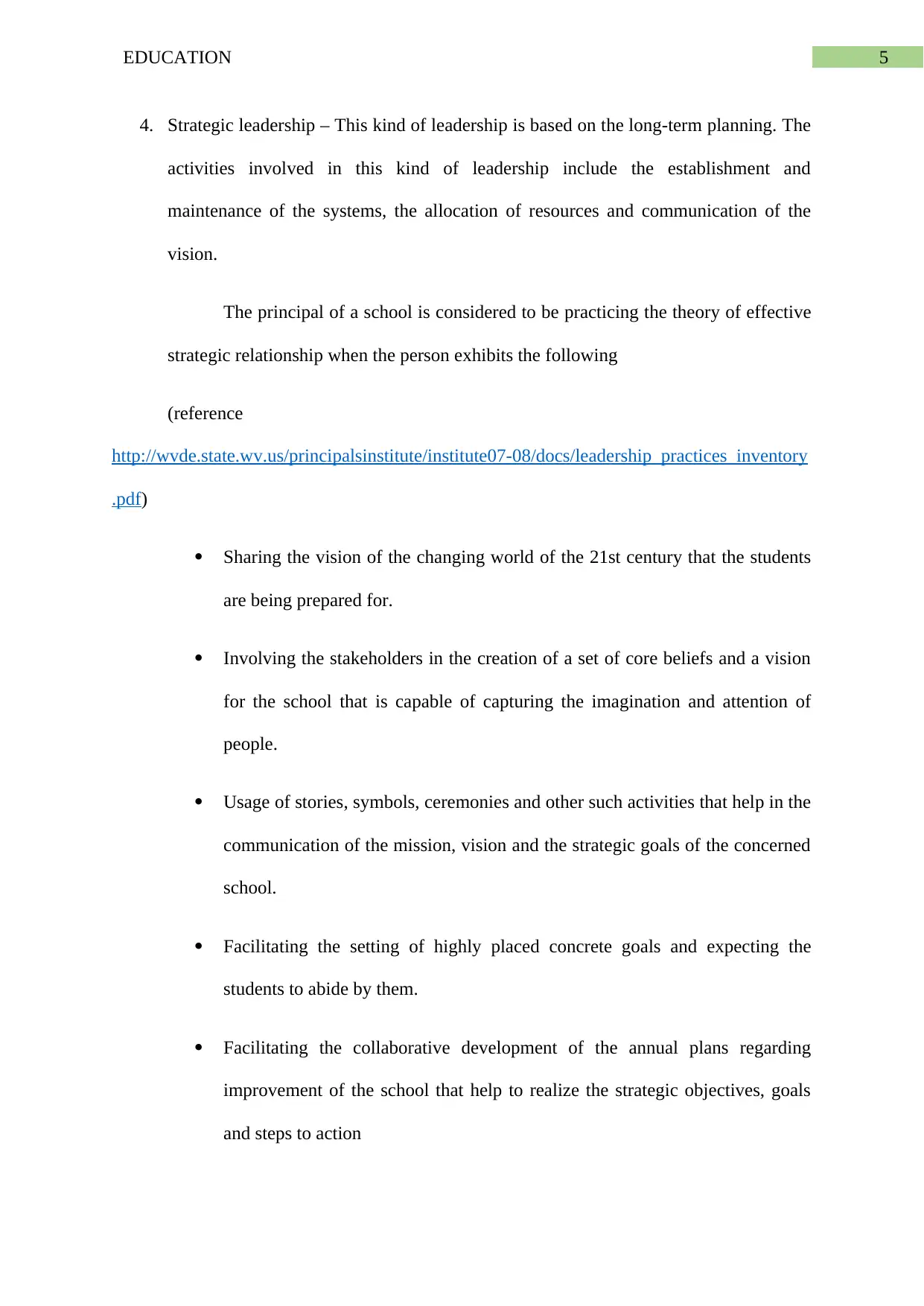
5EDUCATION
4. Strategic leadership – This kind of leadership is based on the long-term planning. The
activities involved in this kind of leadership include the establishment and
maintenance of the systems, the allocation of resources and communication of the
vision.
The principal of a school is considered to be practicing the theory of effective
strategic relationship when the person exhibits the following
(reference
http://wvde.state.wv.us/principalsinstitute/institute07-08/docs/leadership_practices_inventory
.pdf)
Sharing the vision of the changing world of the 21st century that the students
are being prepared for.
Involving the stakeholders in the creation of a set of core beliefs and a vision
for the school that is capable of capturing the imagination and attention of
people.
Usage of stories, symbols, ceremonies and other such activities that help in the
communication of the mission, vision and the strategic goals of the concerned
school.
Facilitating the setting of highly placed concrete goals and expecting the
students to abide by them.
Facilitating the collaborative development of the annual plans regarding
improvement of the school that help to realize the strategic objectives, goals
and steps to action
4. Strategic leadership – This kind of leadership is based on the long-term planning. The
activities involved in this kind of leadership include the establishment and
maintenance of the systems, the allocation of resources and communication of the
vision.
The principal of a school is considered to be practicing the theory of effective
strategic relationship when the person exhibits the following
(reference
http://wvde.state.wv.us/principalsinstitute/institute07-08/docs/leadership_practices_inventory
.pdf)
Sharing the vision of the changing world of the 21st century that the students
are being prepared for.
Involving the stakeholders in the creation of a set of core beliefs and a vision
for the school that is capable of capturing the imagination and attention of
people.
Usage of stories, symbols, ceremonies and other such activities that help in the
communication of the mission, vision and the strategic goals of the concerned
school.
Facilitating the setting of highly placed concrete goals and expecting the
students to abide by them.
Facilitating the collaborative development of the annual plans regarding
improvement of the school that help to realize the strategic objectives, goals
and steps to action
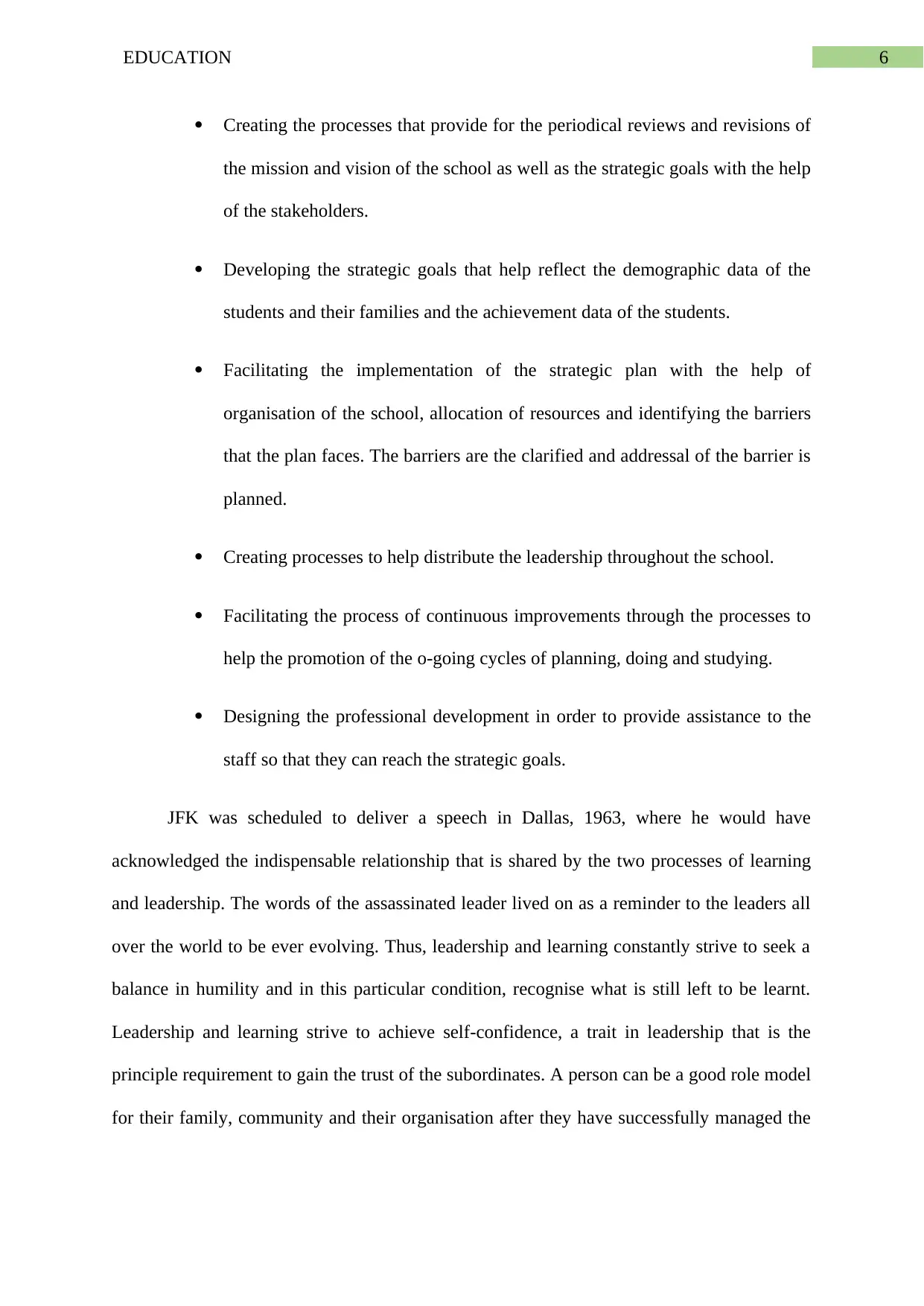
6EDUCATION
Creating the processes that provide for the periodical reviews and revisions of
the mission and vision of the school as well as the strategic goals with the help
of the stakeholders.
Developing the strategic goals that help reflect the demographic data of the
students and their families and the achievement data of the students.
Facilitating the implementation of the strategic plan with the help of
organisation of the school, allocation of resources and identifying the barriers
that the plan faces. The barriers are the clarified and addressal of the barrier is
planned.
Creating processes to help distribute the leadership throughout the school.
Facilitating the process of continuous improvements through the processes to
help the promotion of the o-going cycles of planning, doing and studying.
Designing the professional development in order to provide assistance to the
staff so that they can reach the strategic goals.
JFK was scheduled to deliver a speech in Dallas, 1963, where he would have
acknowledged the indispensable relationship that is shared by the two processes of learning
and leadership. The words of the assassinated leader lived on as a reminder to the leaders all
over the world to be ever evolving. Thus, leadership and learning constantly strive to seek a
balance in humility and in this particular condition, recognise what is still left to be learnt.
Leadership and learning strive to achieve self-confidence, a trait in leadership that is the
principle requirement to gain the trust of the subordinates. A person can be a good role model
for their family, community and their organisation after they have successfully managed the
Creating the processes that provide for the periodical reviews and revisions of
the mission and vision of the school as well as the strategic goals with the help
of the stakeholders.
Developing the strategic goals that help reflect the demographic data of the
students and their families and the achievement data of the students.
Facilitating the implementation of the strategic plan with the help of
organisation of the school, allocation of resources and identifying the barriers
that the plan faces. The barriers are the clarified and addressal of the barrier is
planned.
Creating processes to help distribute the leadership throughout the school.
Facilitating the process of continuous improvements through the processes to
help the promotion of the o-going cycles of planning, doing and studying.
Designing the professional development in order to provide assistance to the
staff so that they can reach the strategic goals.
JFK was scheduled to deliver a speech in Dallas, 1963, where he would have
acknowledged the indispensable relationship that is shared by the two processes of learning
and leadership. The words of the assassinated leader lived on as a reminder to the leaders all
over the world to be ever evolving. Thus, leadership and learning constantly strive to seek a
balance in humility and in this particular condition, recognise what is still left to be learnt.
Leadership and learning strive to achieve self-confidence, a trait in leadership that is the
principle requirement to gain the trust of the subordinates. A person can be a good role model
for their family, community and their organisation after they have successfully managed the
⊘ This is a preview!⊘
Do you want full access?
Subscribe today to unlock all pages.

Trusted by 1+ million students worldwide
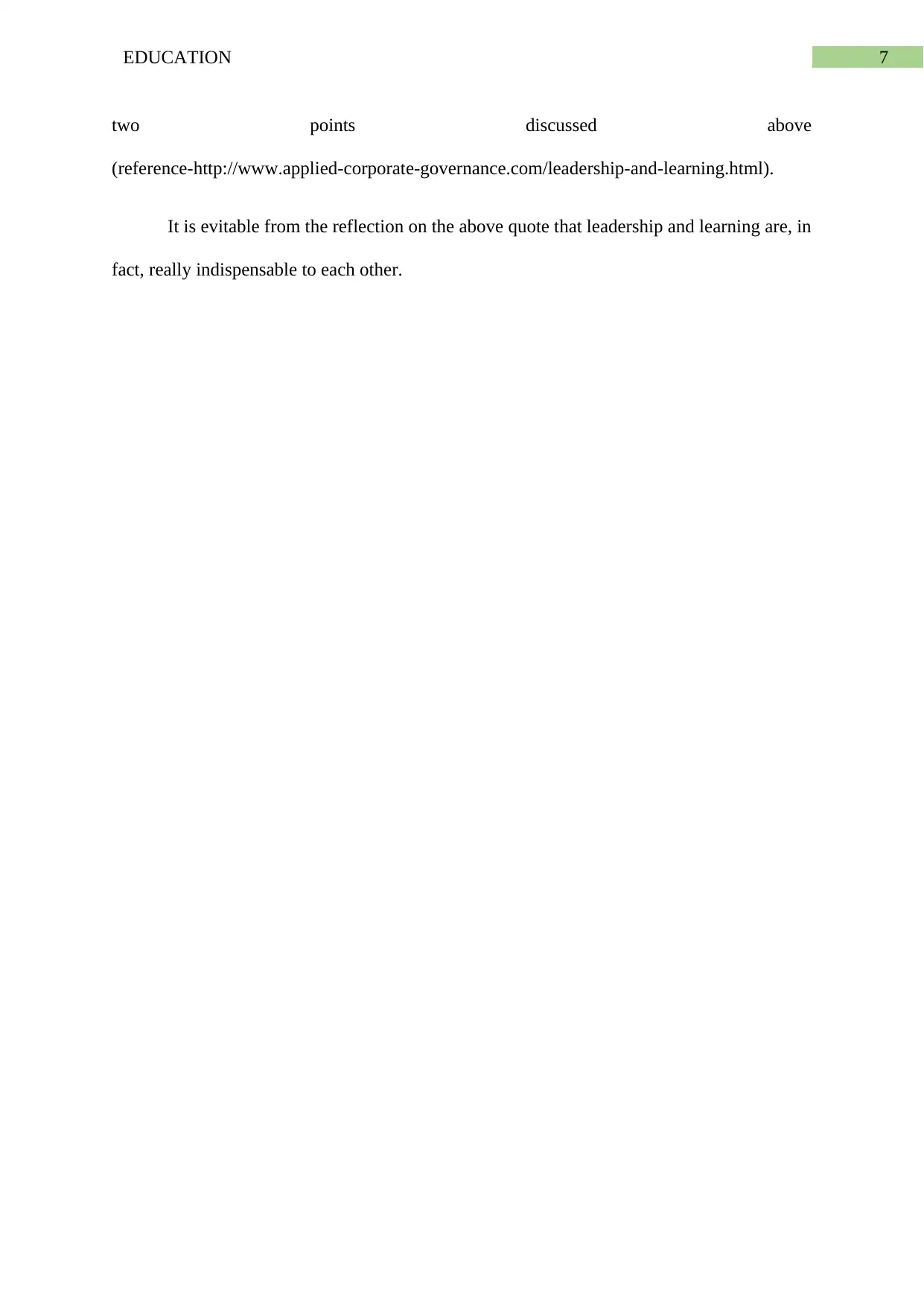
7EDUCATION
two points discussed above
(reference-http://www.applied-corporate-governance.com/leadership-and-learning.html).
It is evitable from the reflection on the above quote that leadership and learning are, in
fact, really indispensable to each other.
two points discussed above
(reference-http://www.applied-corporate-governance.com/leadership-and-learning.html).
It is evitable from the reflection on the above quote that leadership and learning are, in
fact, really indispensable to each other.
Paraphrase This Document
Need a fresh take? Get an instant paraphrase of this document with our AI Paraphraser
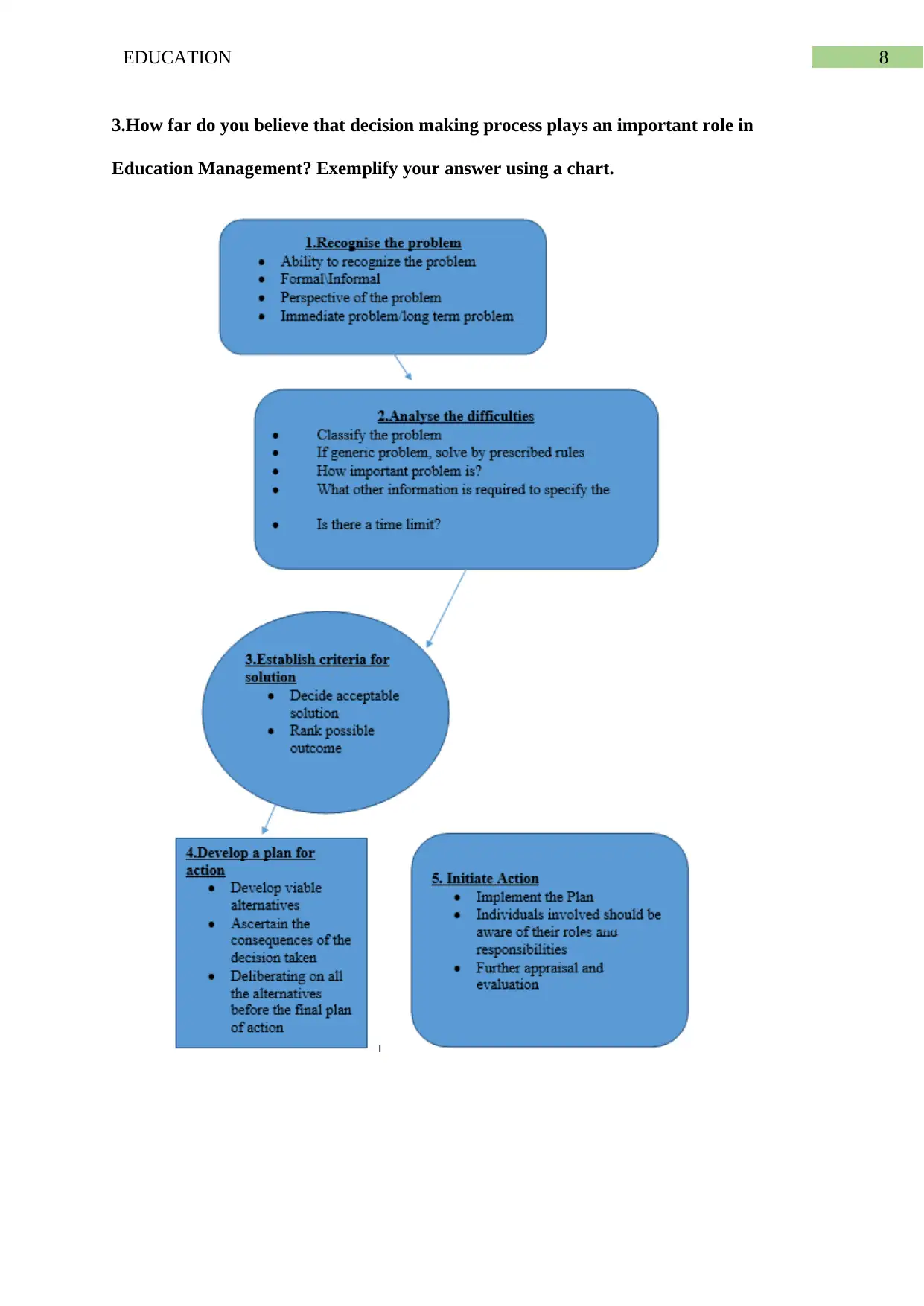
8EDUCATION
3.How far do you believe that decision making process plays an important role in
Education Management? Exemplify your answer using a chart.
3.How far do you believe that decision making process plays an important role in
Education Management? Exemplify your answer using a chart.
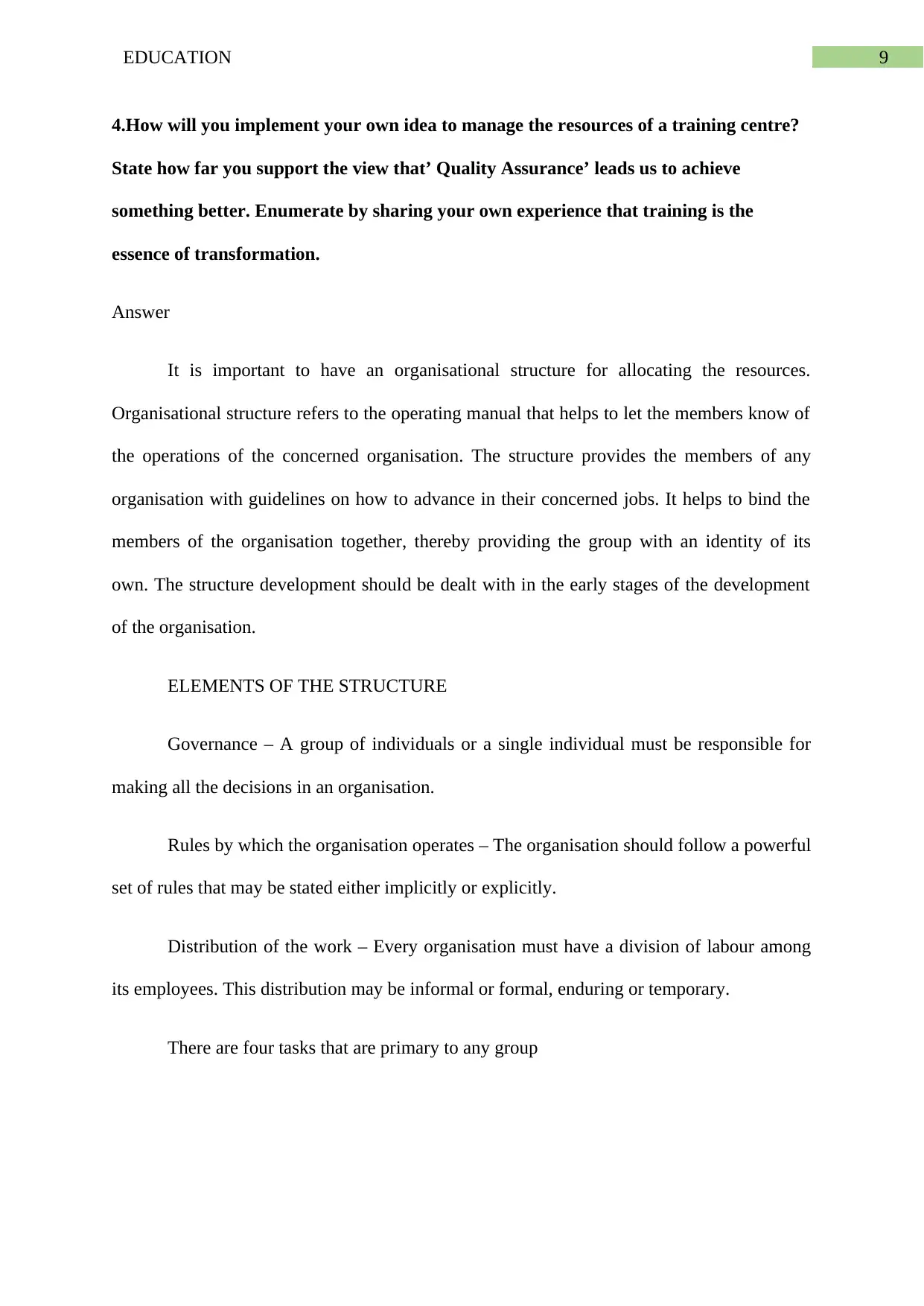
9EDUCATION
4.How will you implement your own idea to manage the resources of a training centre?
State how far you support the view that’ Quality Assurance’ leads us to achieve
something better. Enumerate by sharing your own experience that training is the
essence of transformation.
Answer
It is important to have an organisational structure for allocating the resources.
Organisational structure refers to the operating manual that helps to let the members know of
the operations of the concerned organisation. The structure provides the members of any
organisation with guidelines on how to advance in their concerned jobs. It helps to bind the
members of the organisation together, thereby providing the group with an identity of its
own. The structure development should be dealt with in the early stages of the development
of the organisation.
ELEMENTS OF THE STRUCTURE
Governance – A group of individuals or a single individual must be responsible for
making all the decisions in an organisation.
Rules by which the organisation operates – The organisation should follow a powerful
set of rules that may be stated either implicitly or explicitly.
Distribution of the work – Every organisation must have a division of labour among
its employees. This distribution may be informal or formal, enduring or temporary.
There are four tasks that are primary to any group
4.How will you implement your own idea to manage the resources of a training centre?
State how far you support the view that’ Quality Assurance’ leads us to achieve
something better. Enumerate by sharing your own experience that training is the
essence of transformation.
Answer
It is important to have an organisational structure for allocating the resources.
Organisational structure refers to the operating manual that helps to let the members know of
the operations of the concerned organisation. The structure provides the members of any
organisation with guidelines on how to advance in their concerned jobs. It helps to bind the
members of the organisation together, thereby providing the group with an identity of its
own. The structure development should be dealt with in the early stages of the development
of the organisation.
ELEMENTS OF THE STRUCTURE
Governance – A group of individuals or a single individual must be responsible for
making all the decisions in an organisation.
Rules by which the organisation operates – The organisation should follow a powerful
set of rules that may be stated either implicitly or explicitly.
Distribution of the work – Every organisation must have a division of labour among
its employees. This distribution may be informal or formal, enduring or temporary.
There are four tasks that are primary to any group
⊘ This is a preview!⊘
Do you want full access?
Subscribe today to unlock all pages.

Trusted by 1+ million students worldwide
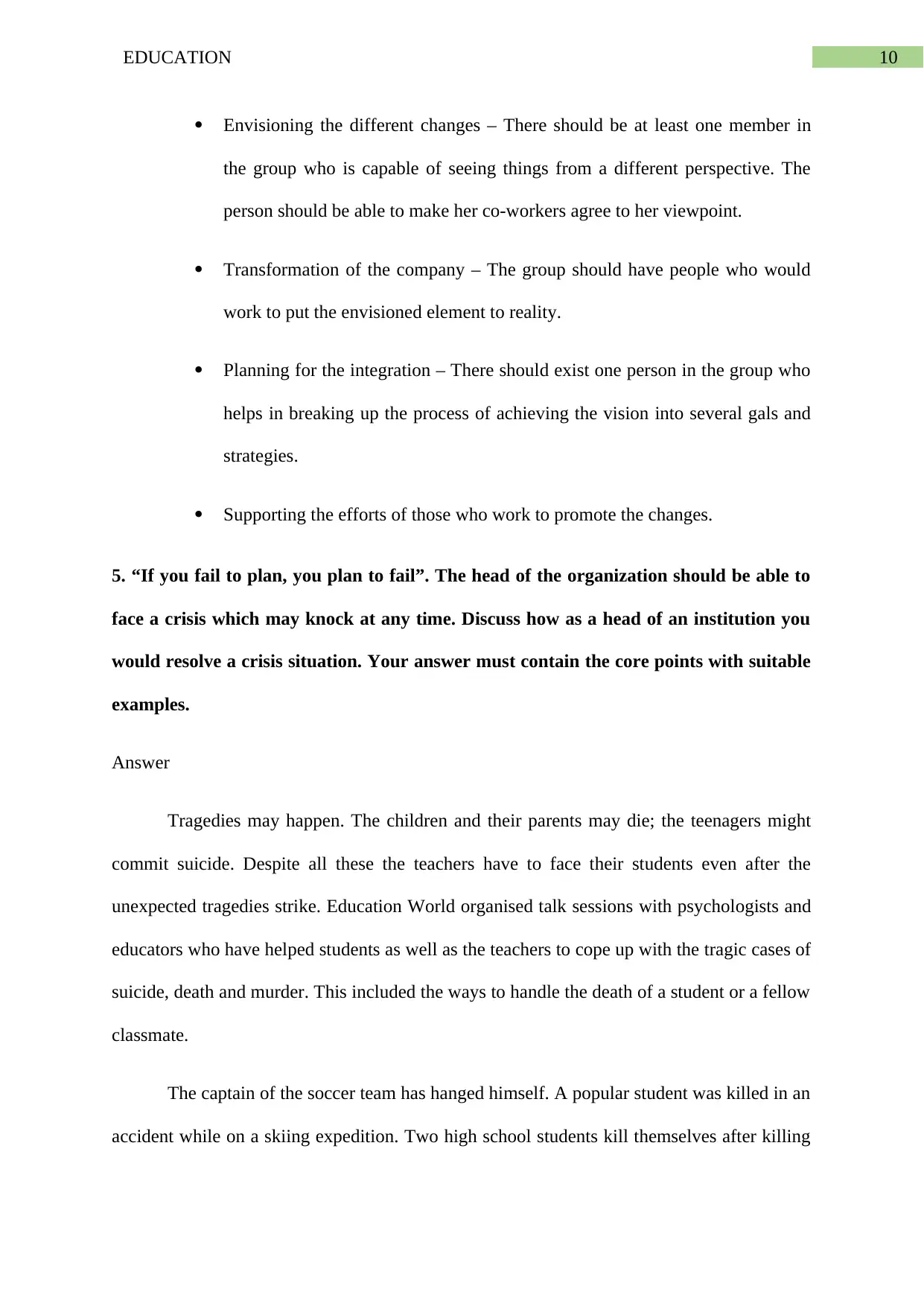
10EDUCATION
Envisioning the different changes – There should be at least one member in
the group who is capable of seeing things from a different perspective. The
person should be able to make her co-workers agree to her viewpoint.
Transformation of the company – The group should have people who would
work to put the envisioned element to reality.
Planning for the integration – There should exist one person in the group who
helps in breaking up the process of achieving the vision into several gals and
strategies.
Supporting the efforts of those who work to promote the changes.
5. “If you fail to plan, you plan to fail”. The head of the organization should be able to
face a crisis which may knock at any time. Discuss how as a head of an institution you
would resolve a crisis situation. Your answer must contain the core points with suitable
examples.
Answer
Tragedies may happen. The children and their parents may die; the teenagers might
commit suicide. Despite all these the teachers have to face their students even after the
unexpected tragedies strike. Education World organised talk sessions with psychologists and
educators who have helped students as well as the teachers to cope up with the tragic cases of
suicide, death and murder. This included the ways to handle the death of a student or a fellow
classmate.
The captain of the soccer team has hanged himself. A popular student was killed in an
accident while on a skiing expedition. Two high school students kill themselves after killing
Envisioning the different changes – There should be at least one member in
the group who is capable of seeing things from a different perspective. The
person should be able to make her co-workers agree to her viewpoint.
Transformation of the company – The group should have people who would
work to put the envisioned element to reality.
Planning for the integration – There should exist one person in the group who
helps in breaking up the process of achieving the vision into several gals and
strategies.
Supporting the efforts of those who work to promote the changes.
5. “If you fail to plan, you plan to fail”. The head of the organization should be able to
face a crisis which may knock at any time. Discuss how as a head of an institution you
would resolve a crisis situation. Your answer must contain the core points with suitable
examples.
Answer
Tragedies may happen. The children and their parents may die; the teenagers might
commit suicide. Despite all these the teachers have to face their students even after the
unexpected tragedies strike. Education World organised talk sessions with psychologists and
educators who have helped students as well as the teachers to cope up with the tragic cases of
suicide, death and murder. This included the ways to handle the death of a student or a fellow
classmate.
The captain of the soccer team has hanged himself. A popular student was killed in an
accident while on a skiing expedition. Two high school students kill themselves after killing
Paraphrase This Document
Need a fresh take? Get an instant paraphrase of this document with our AI Paraphraser
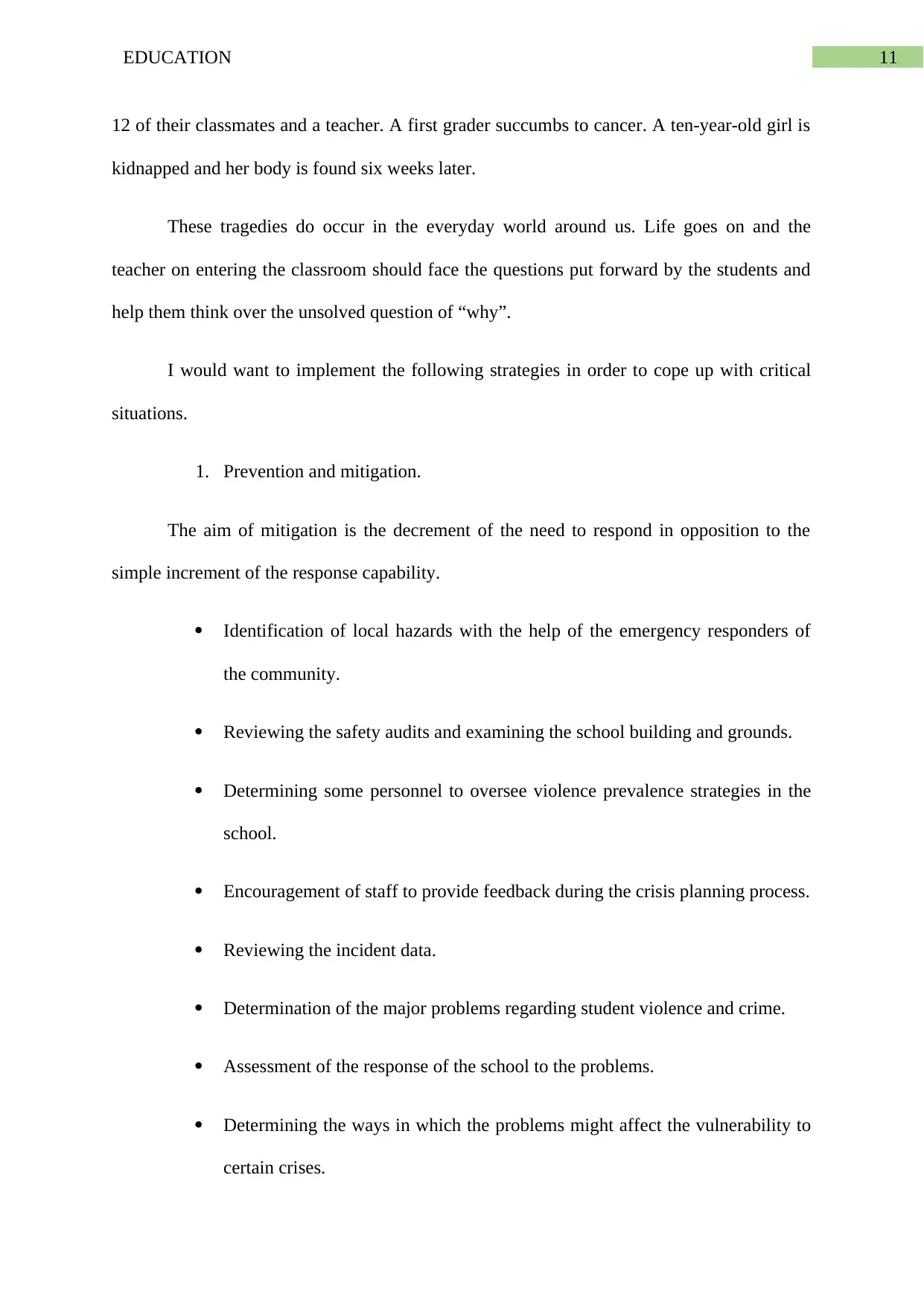
11EDUCATION
12 of their classmates and a teacher. A first grader succumbs to cancer. A ten-year-old girl is
kidnapped and her body is found six weeks later.
These tragedies do occur in the everyday world around us. Life goes on and the
teacher on entering the classroom should face the questions put forward by the students and
help them think over the unsolved question of “why”.
I would want to implement the following strategies in order to cope up with critical
situations.
1. Prevention and mitigation.
The aim of mitigation is the decrement of the need to respond in opposition to the
simple increment of the response capability.
Identification of local hazards with the help of the emergency responders of
the community.
Reviewing the safety audits and examining the school building and grounds.
Determining some personnel to oversee violence prevalence strategies in the
school.
Encouragement of staff to provide feedback during the crisis planning process.
Reviewing the incident data.
Determination of the major problems regarding student violence and crime.
Assessment of the response of the school to the problems.
Determining the ways in which the problems might affect the vulnerability to
certain crises.
12 of their classmates and a teacher. A first grader succumbs to cancer. A ten-year-old girl is
kidnapped and her body is found six weeks later.
These tragedies do occur in the everyday world around us. Life goes on and the
teacher on entering the classroom should face the questions put forward by the students and
help them think over the unsolved question of “why”.
I would want to implement the following strategies in order to cope up with critical
situations.
1. Prevention and mitigation.
The aim of mitigation is the decrement of the need to respond in opposition to the
simple increment of the response capability.
Identification of local hazards with the help of the emergency responders of
the community.
Reviewing the safety audits and examining the school building and grounds.
Determining some personnel to oversee violence prevalence strategies in the
school.
Encouragement of staff to provide feedback during the crisis planning process.
Reviewing the incident data.
Determination of the major problems regarding student violence and crime.
Assessment of the response of the school to the problems.
Determining the ways in which the problems might affect the vulnerability to
certain crises.
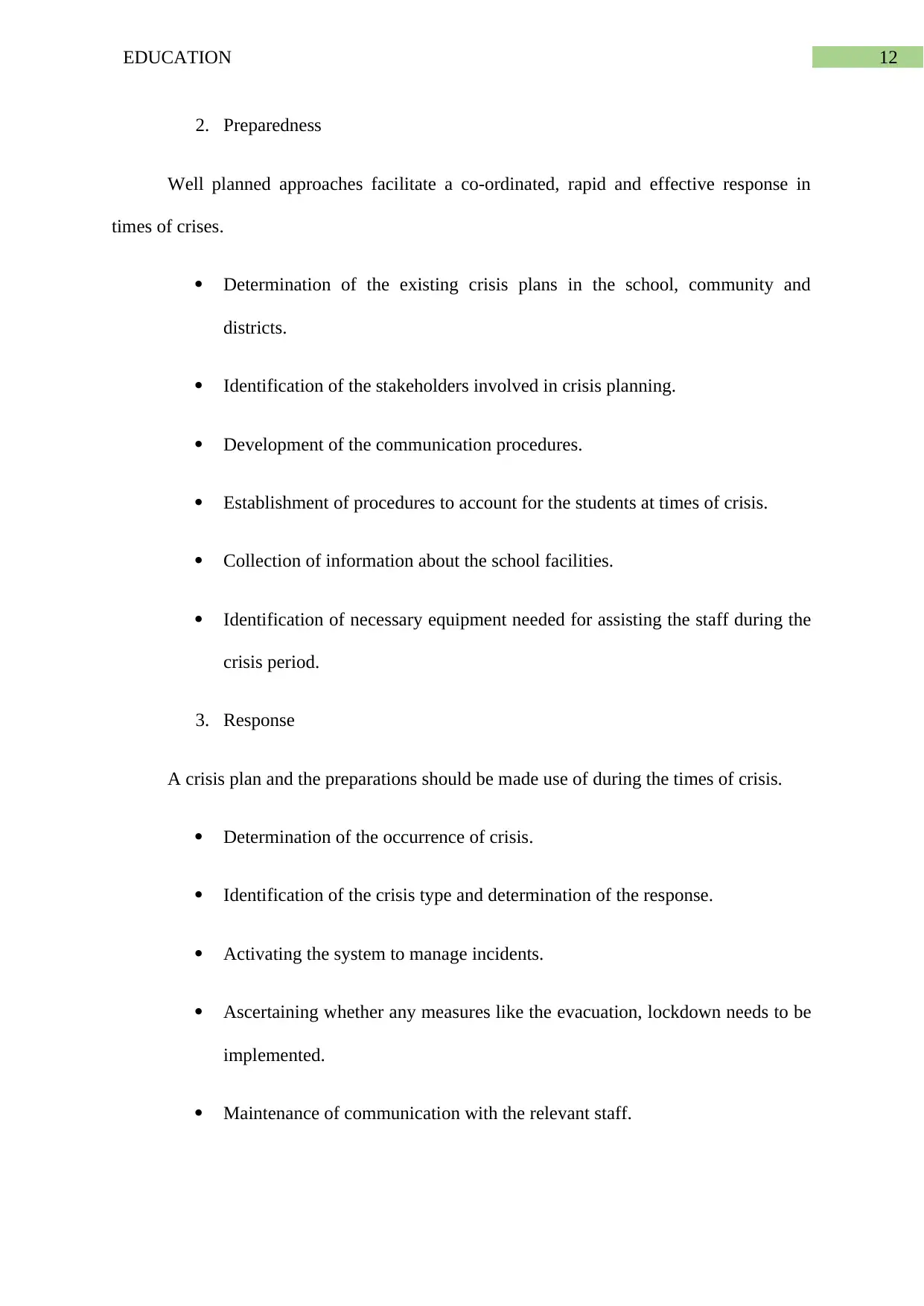
12EDUCATION
2. Preparedness
Well planned approaches facilitate a co-ordinated, rapid and effective response in
times of crises.
Determination of the existing crisis plans in the school, community and
districts.
Identification of the stakeholders involved in crisis planning.
Development of the communication procedures.
Establishment of procedures to account for the students at times of crisis.
Collection of information about the school facilities.
Identification of necessary equipment needed for assisting the staff during the
crisis period.
3. Response
A crisis plan and the preparations should be made use of during the times of crisis.
Determination of the occurrence of crisis.
Identification of the crisis type and determination of the response.
Activating the system to manage incidents.
Ascertaining whether any measures like the evacuation, lockdown needs to be
implemented.
Maintenance of communication with the relevant staff.
2. Preparedness
Well planned approaches facilitate a co-ordinated, rapid and effective response in
times of crises.
Determination of the existing crisis plans in the school, community and
districts.
Identification of the stakeholders involved in crisis planning.
Development of the communication procedures.
Establishment of procedures to account for the students at times of crisis.
Collection of information about the school facilities.
Identification of necessary equipment needed for assisting the staff during the
crisis period.
3. Response
A crisis plan and the preparations should be made use of during the times of crisis.
Determination of the occurrence of crisis.
Identification of the crisis type and determination of the response.
Activating the system to manage incidents.
Ascertaining whether any measures like the evacuation, lockdown needs to be
implemented.
Maintenance of communication with the relevant staff.
⊘ This is a preview!⊘
Do you want full access?
Subscribe today to unlock all pages.

Trusted by 1+ million students worldwide
1 out of 16
Related Documents
Your All-in-One AI-Powered Toolkit for Academic Success.
+13062052269
info@desklib.com
Available 24*7 on WhatsApp / Email
![[object Object]](/_next/static/media/star-bottom.7253800d.svg)
Unlock your academic potential
Copyright © 2020–2025 A2Z Services. All Rights Reserved. Developed and managed by ZUCOL.





